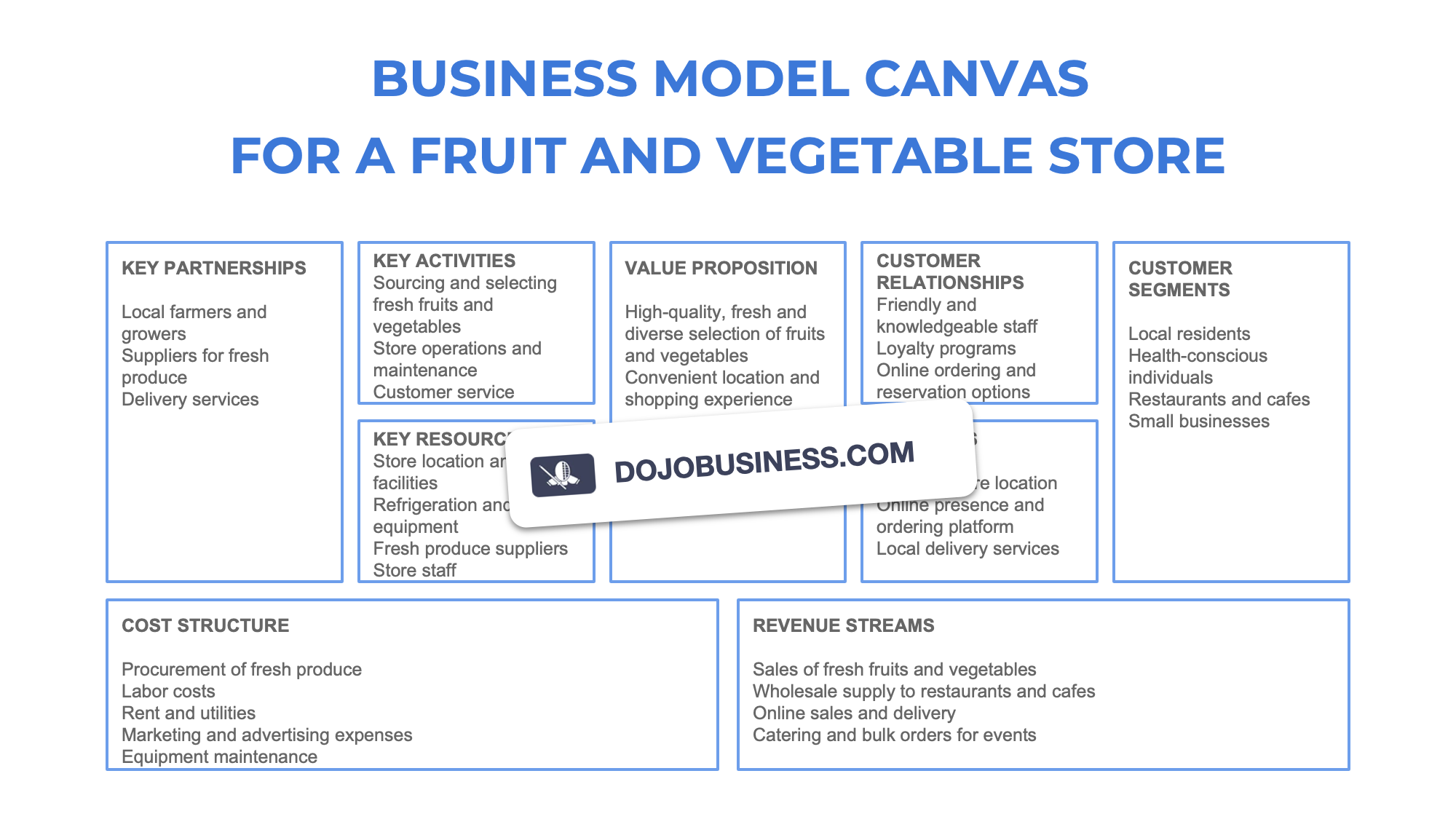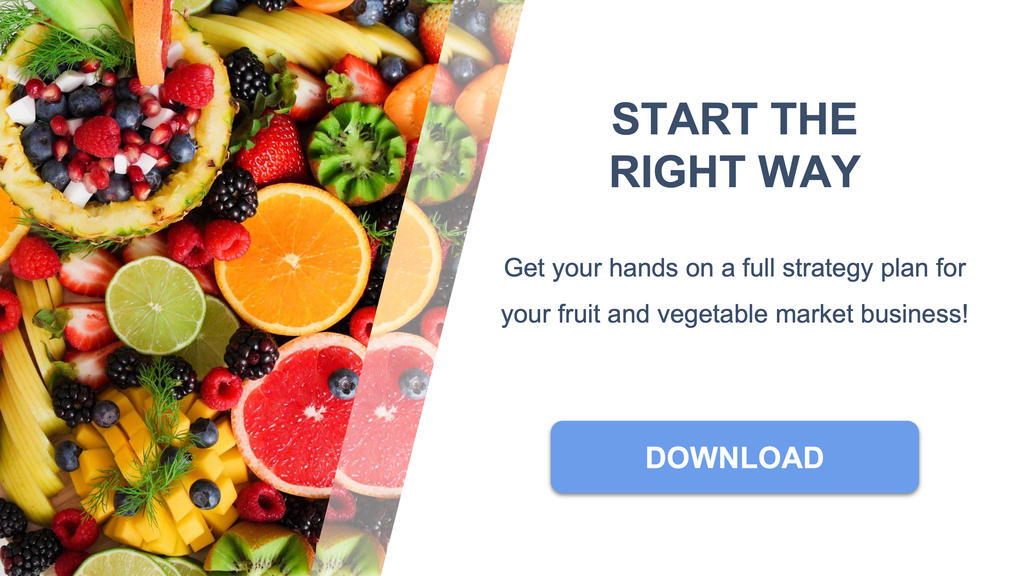
Get a watermark-free, fully customizable business model canvas in our business plan for a fruit and vegetable store
In the vibrant marketplace of fresh produce, having a clear and effective strategy is essential for your fruit and vegetable store to thrive.
Welcome to your detailed guide on applying the Business Model Canvas framework, customized for the unique needs of fruit and vegetable retailers.
This piece simplifies the framework into manageable sections, enabling you to pinpoint your value proposition, define your target customers, outline key operations, and much more.
Should you be looking for a ready-to-use Business Model Canvas that's fully customizable, feel free to explore our business plan template designed specifically for a fruit and vegetable store.
What is a Business Model Canvas? Should you make one for your fruit and vegetable store?
A Business Model Canvas is a strategic tool designed to help you map out the key components of your business, whether you're starting fresh or re-evaluating an existing business.
Imagine it as a visual framework that captures your fruit and vegetable store's value proposition, operations, customers, and financials in one succinct diagram.
In the context of a fruit and vegetable store, this canvas serves as a roadmap that illustrates how your store will generate revenue, attract and retain customers, and manage your resources effectively.
Why do people create a Business Model Canvas? It's simple. For owners of a fruit and vegetable store, the canvas offers a clear and concise picture of the business's core aspects. It helps you understand how you'll provide value to your customers, differentiate yourself from competitors, and maintain a profitable operation.
This might involve detailing your sources of fresh produce, your marketing tactics to attract health-conscious consumers, or your delivery services that set you apart from other stores.
The benefits are clear-cut.
It promotes strategic planning and helps you concentrate on the essentials. It can reveal unforeseen challenges or opportunities, allowing you to refine your approach before you invest too much time or money.
For example, you might discover that your plan to source exotic fruits isn't as viable as offering locally-grown, organic produce that appeals to your community's preferences. Such insights can be invaluable.
Should you create one if you're embarking on a new fruit and vegetable store venture? Definitely.
It's an essential part of the planning process that can steer your decisions and strategies. It enables you to communicate your vision to potential investors or partners in a clear and succinct manner. A well-thought-out Business Model Canvas, similar to the one you'll find in our business plan template tailored for a fruit and vegetable store, can transform a vague idea into a concept backed by a strategic market understanding.
Is it useful for you? Absolutely, especially if you aim to establish a clear direction for your store. It compels you to methodically work through your business model and assess the viability of your store concept.
Moreover, it's a dynamic document that you can modify as your store expands or as the market evolves.

How to create a Business Model Canvas for your fruit and vegetable store?
Creating a Business Model Canvas for your fruit and vegetable store should be straightforward.
You can simply adapt the one we have already created and filled in our business plan template designed for a fruit and vegetable store.
Need more details? Let's dive into each section of the canvas, and we'll guide you on how to complete it with ideas and strategies, using a clear and concise approach.
Value Proposition
Let's start with the Value Proposition.
This is the core of your fruit and vegetable store. What sets your store apart? Is it the locally-sourced produce, the organic selection, or perhaps the convenience and customer service?
Consider what will make customers prefer your store over others.
It could be your commitment to sustainability, the variety of exotic fruits and vegetables you offer, or the freshness guarantee you provide.
Customer Segments
Moving on to Customer Segments.
Who are your customers? Are you catering to health-conscious individuals, families looking for quality produce, or perhaps chefs and restaurants in need of premium ingredients?
Understanding your target audience will influence many of your choices, from product range to pricing policies.
Channels
Now, let's consider Channels.
How will you reach your customers? This might include a physical storefront complemented by online sales.
Think about leveraging social media to showcase your fresh produce, a website for online shopping and delivery options, and local advertising to engage the community.
Remember the importance of word-of-mouth and think about ways to motivate customers to refer friends and family.
Customer Relationships
Customer Relationships are about how you connect with your customers and ensure they return.
Outstanding customer service, rewards for regular shoppers, and responding to customer feedback are crucial.
Consider how you can use technology to improve the shopping experience, such as a loyalty app or online order tracking.
Revenue Streams
In the Revenue Streams section, you'll think about how your store will generate income.
Beyond direct sales, consider additional streams like offering subscription boxes, hosting educational workshops, or partnering with local businesses for produce supply.
Be innovative and think about what aligns with your brand and customer needs.
Key Activities
On the flip side, we have Key Activities.
These are the critical tasks required to run your store. This includes sourcing produce, managing stock, marketing, and customer service.
Identify the activities that are essential to delivering your value proposition and how you can perform them effectively.
Key Resources
Key Resources are the assets vital to your operation.
This includes your storage facilities, your staff, your relationships with farmers, and even your store's location. Reflect on what you need to succeed and how you can obtain these resources.
Key Partnerships
Key Partnerships might involve local farmers, organic certifiers, or collaborations with community organizations.
For example, partnering with a local composting service can help you manage waste and support community gardens.
Cost Structure
Finally, Cost Structure.
Operating a fruit and vegetable store comes with various expenses, from lease and employee wages to procurement and marketing costs. Understanding these will help you manage your finances effectively.
It's crucial to distinguish between fixed costs, like rent, and variable costs, like inventory, to budget wisely.
What should be included in each section of the Business Model Canvas for a fruit and vegetable store?
Unsure about how to tailor the Business Model Canvas for your fruit and vegetable store? You can start by modifying the template we've included in our business plan template.
Here's a guide with examples to help you fill out each section of the Business Model Canvas for a fruit and vegetable store.
| Component | Examples |
|---|---|
| Key Partners | Local farmers, Organic produce suppliers, Delivery companies, Payment processing services, Business associations |
| Key Activities | Procurement of fresh produce, Inventory management, Quality control, Customer service, Home delivery services |
| Key Resources | Refrigeration units, Inventory management software, Delivery vehicles, Storefront, E-commerce website |
| Value Propositions | Fresh, locally-sourced produce, Organic and non-GMO options, Subscription boxes, Health and nutrition information, Seasonal specials |
| Customer Relationships | Personalized shopping assistance, Community events, Loyalty discounts, Newsletter with health tips and recipes, Responsive customer support |
| Channels | Physical store, Online store, Social media, Local markets, Delivery apps |
| Customer Segments | Health-conscious consumers, Local residents, Restaurants and cafes, Schools and institutions, Event organizers |
| Cost Structure | Purchasing cost of produce, Staff wages, Store maintenance, Delivery and logistics, Marketing and promotional expenses |
| Revenue Streams | Retail sales, Online orders, Wholesale to businesses, Seasonal promotions, Workshops on healthy eating |

Examples of Business Model Canvas for a fruit and vegetable store
Below are examples of business model canvas of three different types of fruit and vegetable stores: Organic Produce Store, Discount Produce Market, and Exotic Fruit Boutique.
Organic Produce Store Business Model Canvas
| Component | Description |
|---|---|
| Key Partners | Organic farmers, sustainable packaging suppliers, health food companies |
| Key Activities | Sourcing organic produce, quality control, community education on healthy eating |
| Value Propositions | High-quality organic produce, environmentally friendly practices, health-conscious offerings |
| Customer Relationships | Subscription boxes, newsletters with health tips, loyalty discounts |
| Customer Segments | Health-conscious consumers, eco-friendly shoppers, organic food enthusiasts |
| Key Resources | Direct relationships with organic farms, knowledgeable staff, store location |
| Channels | In-store shopping, online orders, community farmers' markets |
| Cost Structure | Organic certification costs, premium produce prices, employee training |
| Revenue Streams | Sales of organic fruits and vegetables, eco-friendly product lines, educational workshops |
Discount Produce Market Business Model Canvas
| Component | Description |
|---|---|
| Key Partners | Bulk produce suppliers, local farms with surplus produce, discount retailers |
| Key Activities | Bulk buying, inventory management, aggressive pricing strategies |
| Value Propositions | Low prices, daily deals, wide variety of produce |
| Customer Relationships | Volume discounts, weekly flyers, in-store promotions |
| Customer Segments | Budget shoppers, small businesses, families |
| Key Resources | Warehouse-style store, efficient supply chain, cost-effective marketing |
| Channels | In-store shopping, discount flyers, word-of-mouth |
| Cost Structure | Low-margin, high-volume sales, minimal staffing, cost-saving store design |
| Revenue Streams | Sales of discounted fruits and vegetables, bulk sales to small businesses |
Exotic Fruit Boutique Business Model Canvas
| Component | Description |
|---|---|
| Key Partners | International fruit importers, specialty food distributors, gourmet food shops |
| Key Activities | Importing exotic fruits, maintaining freshness, customer education on unique produce |
| Value Propositions | Rare and exotic fruit offerings, premium customer experience, gift packaging |
| Customer Relationships | Personalized shopping assistance, tasting events, exclusive memberships |
| Customer Segments | Gourmet shoppers, culinary professionals, gift buyers |
| Key Resources | Exclusive supplier contracts, refrigerated display cases, upscale store location |
| Channels | Boutique store, online store, gourmet food events |
| Cost Structure | Import and handling costs, premium store maintenance, specialized staff |
| Revenue Streams | Sales of exotic fruits, gift baskets, membership fees |

You can also read our articles about:
- how to build a marketing strategy for your fruit and vegetable store
- how to segment the customers of your fruit and vegetable store
- how to make a competition study for your fruit and vegetable store
- how to open a fruit and vegetable market (guide)
